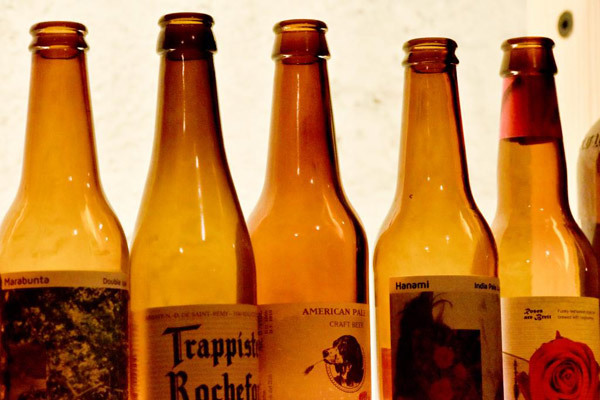- The resurrection of the bread of the pharaohs, a story with crumb
- The first yeast with DNA made in the laboratory
Mixing or hybridization of species usually results, as is the case with mules, an infertile offspring, when not directly unfeasible. But there are always exceptions. An international team of scientists has just discovered a hybrid whose strange combination of genes hides the secret of a flavor that has been in vogue since the Middle Ages: the yeasts of traditional Belgian beer . And it is not the only drink whose secrets science is bringing us closer to.
In fact, another study that has been published in the same issue of 'Nature Ecology and Evolution', and in which the Higher Council for Scientific Research (CSIC) has participated, has identified dozens of new yeast hybrids used in various kinds of drinks, such as beer, wine, cider or champagne. They presumably contain numerous clues about the taste and other characteristics of these products .
In total, more than 120 hybrid strains of yeasts have been identified, coming from genetic combinations between two, three or even four different species. The results, the authors trust, will allow the development of new and better strains.
"All the information obtained allows us to better understand the domestication processes that have occurred throughout history and, therefore, to design better protocols for the generation of new industrial strains," explains CSIC researcher David Peris of the Institute of Agrochemistry. and Food Technology.
The study in which Peris has participated, led by the University of Wisconsin-Madison, has determined that the characteristic mild flavor of lager-type beers is achieved by the absence of phenolic aromas, which are inactivated by yeast hybrids. Present in these beers.
On the contrary, in other varieties, such as trapista beer, these aromas are highly valued, and the hybrids isolated in them maintain the production of these phenols.
Precisely, in the other study, led by the VIB Institute in Leuven, the genetic sequencing of many of these fungi has revealed a curious hybrid between the traditional brewer's yeast, or 'Saccharomyces cerevisiae', and the much less common 'Saccharomyces kudriavzevii '. The first species is usually used in the production not only of beer, but also of bread or wine, and its main quality is that it facilitates fermentation. The second, more 'wild', provides genes more resistant to stress and cold, which translates into a greater ability to create flavors and aromas .
Adaptation to a domestic environment
In a sense, the genetic adaptation of beer yeasts is comparable, according to scientists, to that of the dogs themselves. Like pets, this species of fungi has lived with humans in homes and places of homemade manufacture for centuries , in which it has undergone several genetic changes and has adapted to an environment very different from the natural landscape from which they come.
The newly detected varieties are, therefore, a product of centuries of brewing, but also of unexpected crossings between 'domesticated' species and another of feral origin, as in the case of the Belgian strain. "It seems that these unique natural yeasts allowed the development of some of the beers that Belgium is famous for," explains Philippe Malcorps, one of the authors of the study and expert in Innovation and Technology at AB InBev.
"These yeasts are hybrids of two completely different species . Let's think about tigers and lions making a super baby together," says Jan Steensels, who has coordinated laboratory work at the University of Leuven.
The hybrid is present today, according to the authors of the study, in two known varieties of beer: the trapense and the gueuze (in turn, a limbic variety). But the process of 'domestication' did not stop in this genetic combination, but the yeasts continued to adapt to the different environments and modes of production in which they were.
Therefore, the yeasts of the two kinds of beers mentioned are different today, although both come from the same species union. "The lineage probably originated in a single hybridization event and then separated into two distinct subgroups, the lactic and Trappist strains, which function in two totally different beer production processes," the study details.
Loss of diversity
In the last 150 or 200 years, the industrialization and standardization of beer brewing processes has led to a loss in the variety of yeasts , researchers argue, but craft beers like those mentioned offer an exception to this trend, as shown the presence of the newly identified hybrid.
"The use of medieval manufacturing technologies , such as outdoor inoculation, long-term fermentation and storage in barrels stored in the brewer's basement, has promoted the survival of the unique yeast hybrids presented in this study" .
A presence proposed by the researchers could now become a new "source of biodiversity for industrial applications." In fact, the research, which has been developed over five years and has been funded by private companies, has found multiple kinds of yeast hybrids, apart from that present in traditional Belgian beers.
Much of these new hybrid species originated in medieval Germany , and from there they spread to Belgium, where they have been found, and the rest of Europe, as the techniques and materials for brewing became popular in the continent.
"It is no coincidence that the origin of today's beer yeasts is in Belgium and Germany, probably two of the countries most associated with the art of fermentation," concludes Mathias Hutzler, professor at the Technical University of Munich.
According to the criteria of The Trust Project
Know more- science
- Science and Health
AmbienteMatt McGrath of the BBC, awarded by the FBBVA for informing and "inspiring" about the challenges of the planet
Science At least four Iberian lynxes killed by shotgun shots and traps of the poachers in Castilla-La Mancha
Illegal traffic One in five animal species is already sold on the black market

